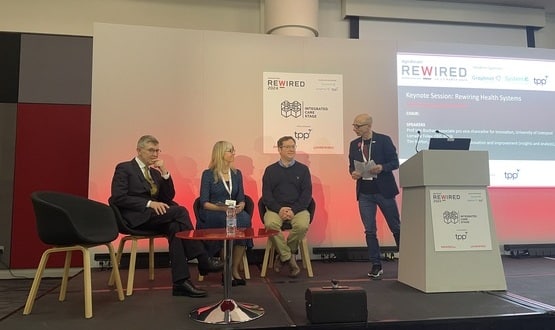The challenges of leading Cerner UK during the Covid-19 pandemic
- 19 November 2020

In an interview with Digital Health, Distie Profit, the UK managing director of Cerner, speaks to Jon Hoeksma about the challenges of leading one of the largest suppliers of electronic patient records software in the NHS during the Covid-19 pandemic.
Cerner has the second largest installed base of hospital systems in the NHS, second only to DXC. The company has been in the NHS market for over 20-years, with the UK being the company’s most important market outside the US.
Though best known for its Cerner Millennium Electronic Patient Record (EPR), which was widely installed in London and the South under the National Programme for IT, it is today increasingly focused on healthcare integrations platforms, population health management and patient engagement.
Distie Profit, who has been Cerner UK’s managing director since January 2019, spoke to Digital Health News, about her background and the challenges of leading in the midst of a pandemic.
Farm kid from Iowa to the White House
Speaking about her upbringing, Profit describes herself as “a farm kid from Iowa, who got into politics”, and says her father instilled in her a sense of mission.
“He never said we were farmers, rather that we were ‘feeding the world’, and that kind of stuck,” she says.
Growing up in Iowa, a state which is known for being a swing state during presidential elections, led Profit to studying politics. This was followed by a stint working at White House under George W Bush.
“I was at the White House during 9-11, which was a very different crisis to the current pandemic but similar from a leadership perspective,” she explains.
“I was then part of the transition team for the Department for Homeland Security and worked at the Department for a number of years, before being recruited to Cerner 16 years ago.”
While there is no family tradition of working in medicine, Profit says she was attracted by the same sense of mission, and recounts that she had an aunt who died of sepsis at the age of 30.
“The data was available but wasn’t joined up across the system, and so her death was not avoided when it could have been,” she adds.
Leadership styles
Talking about her leadership style in the current crisis, Profit says communication and empathy are core.
“It’s about knowing the stress people are working under in the face of a crisis and doing everything we can to help maintain people’s mental health and well-being,” she says.
“Sometimes it’s just the simple things like starting a meeting with asking ‘are you OK?’”
Another key issue for Profit is diversity and inclusion and she is keen to express that she believes the pair go “hand-in-hand”.
“I strongly believe they have to go hand-in-hand all the time, because even if you are surrounded by a diverse workforce if you are not being inclusive of the opinions and experience that everyone brings to the table, I’m not sure it matters,” she says.
“A lot of it comes by leading by example. That old adage of ‘it’s hard to be what you can’t see’ really holds true.”
Pandemic partnerships
Profit says that she is proud of the work Cerner and partners have done during the pandemic, ranging from the sharing of information, to a Covid-19 care pathway tool that helped with the flow of patients through emergency departments.
Over the last few months the supplier has also been helping trusts reconfigure systems to create green and red areas and has also worked with North Central London STP to better care for shielded and vulnerable patients and create transfers of care dashboards.
There has also been the well-publicised work on Nightingale hospitals in London and the North-east.
Population health focus
Over the past five years Profit says Cerner has developed a strong population health focus.
“Through our Health Information Exchange and HealtheIntent platforms we are now not only aggregating data from across the health and care system, but also ensuring that intelligence is applied to it to produce actionable insights,” she adds.
“The UK was the first country outside the US to adopt Cerner’s population health platform, HealtheIntent [Wirrall] connecting systems and Integrated Care Systems, including the Healthy Wirral partnership, North Central London and Lewisham STPs, the Hampshire and Isle of Wight ICS and the OneLondon LHCRE, connecting up information from multiple settings and systems.”
Profit acknowledges however, that NHS acute trusts still command the lion’s share of investment.
“Acutes remain where the spend has been focused – while the acutes don’t need to be the driver of population health a lot of the time they wind up being the focus as they are the holder of those funds,” she says.
Helping vaccinate the globe
Part of their work on population health management is also starting to help with the fight against coronavirus.
“The work around population health management that we did with some of our clients during the first wave of COVID-19 is now being extended to also help them target flu and COVID vaccination programmes,” Profit reveals.
One example includes the use of their PHM tools for equity audits to identify demographics or communities with low vaccine uptakes, enabling them to change the approach in their communication and campaign strategies, a use case that has clear applicability to the forthcoming COVID-19 vaccination programme.
“Another use case has seen clients identify additional factors, such as having a learning disability, that would greatly increase a person’s risk of requiring hospital admission if diagnosed with flu,” she adds.
“These are hugely valuable insights as we reinforce our focus on addressing health inequalities at both a population and a personal level.”
Accelerating digital efforts
Asked whether she thinks the Global Digital Exemplar programme, in which Cerner was supplier to the largest number of NHS trusts, has been successful in accelerating digitisation efforts, Profit says: “I think it has been successful in accelerating the digitisation of those organisations whom got that stimulus – it has increased the pace and collaboration.”
“The challenge is that if organisations didn’t have money to spend on digital and accompanying change programmes on quality and operations, then I don’t think they’ve been able to move on, at least not at the same pace, which is where you get the variance across health and care and across the country.
NHSX is currently bidding for up to £3 billion investment in provider digitisation. Although it would be a welcome slice of investment, Profit says that a significant number of NHS trusts still need to digitise.
“There are still a sizeable number of trusts and social care that have not yet digitised, and £3 billion is still not a lot to complete provider digistisation,” Profit adds.
She also says Cerner is currently working with a broad range of organisations to get foundational elements in.
“Those that do have foundations in place can also digitise care pathways and use the data that becomes available to track patterns and reduce variance in care, and then take those new digital care pathways across the health and care system,” explains Profit.
“This is what we are now doing with reference organisations like Royal Free.”
Stiff competition
Over the past few years Cerner has faced stiff competition in the UK from Epic, which has won a string of high-profile contracts with some of the most prestigious NHS trusts, UCL, GOSH, Guys and St Thomas’, and Frimely as well as big regional deals with Northern Ireland and Manchester.
Over the period Epic has developed an enviable reputation for enabling clients to rapidly achieve high levels of digitisation. Both GOSH and Cambridge have recently reached HIMSS Level 7.
Asked whether Epic is winning the big NHS deals, Profit says: “I’d challenge that view and point out that Cerner has similarly high-profile clients, including Imperial, Oxford, Barts, the Royal Free and Newcastle, Additionally, we partner with a range of providers and enable whole health systems across the country
“We’ve been selected by more than 10 Acute Trusts and Integrated Care Systems in the past couple of years.”
She also rejects the suggestion that Epic’s NHS clients are achieving better outcomes, quicker, pointing out that many Cerner clients have achieved HIMSS Level 7 around the world and notes “several more Cerner clients have chosen to pursue accreditation to Level 6 and are in the process right now”.
Rise of the consumer
Looking ahead she says Cerner believes the future is about building on baseline digitisation and integration to then enable the automation of workflows, underpinned by a commitment to interoperability.
Profit also highlights the rise of consumer healthcare with a high-profile example being when Oxford and Milton Keynes became the UK launch sites for Apple’s Health Records feature, linking data from the trust’s Millennium EPRs to people’s iPhones.
And in August, Cerner announced a partnership with Amazon’s new cloud linked fitness tracker Halo, The Amazon tie-up with Cerner, due to reach the UK in coming months, will enable to share activity, sleep, body fat percentage and other important wellness data with their health and care providers.
“The future will be much more citizen-centric in the care process,” Profit says.
“So, it’s not just paying lip-service to the person but understanding the citizen. That’s where much bigger change will come.”
She says that the experience of the ongoing pandemic has shifted perceptions of the role of digital in health and care in ways likely to endure.
“I think that as the crisis continues to linger, the more people will have a real recognition that we can’t go back to the way we were. Our interactions through these new ways of working are becoming more natural. Plus I think we’ll continue to experience the acceleration of consumer engagement and them being more demanding of how and where they get their care.”




